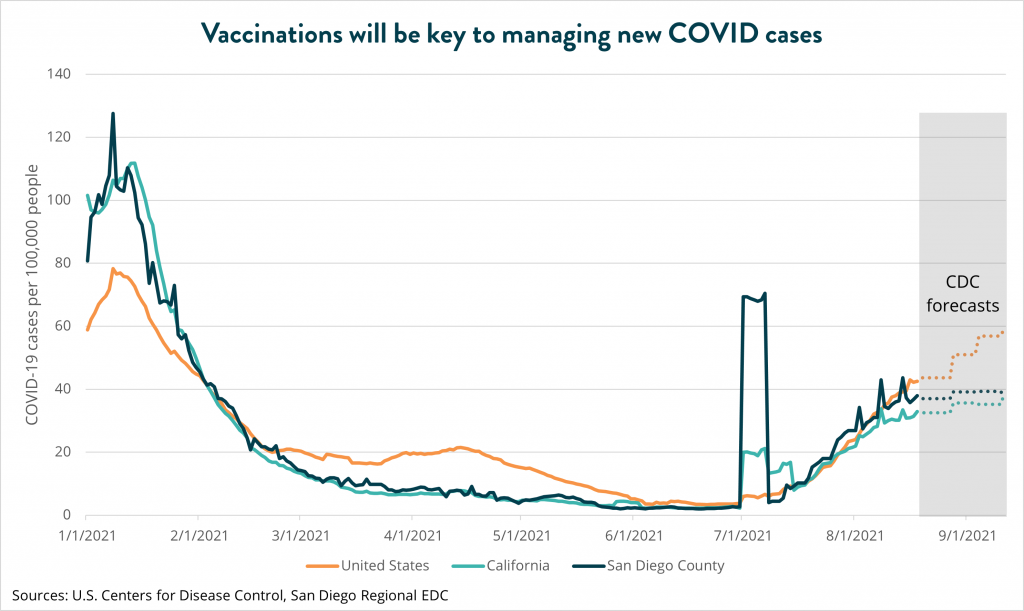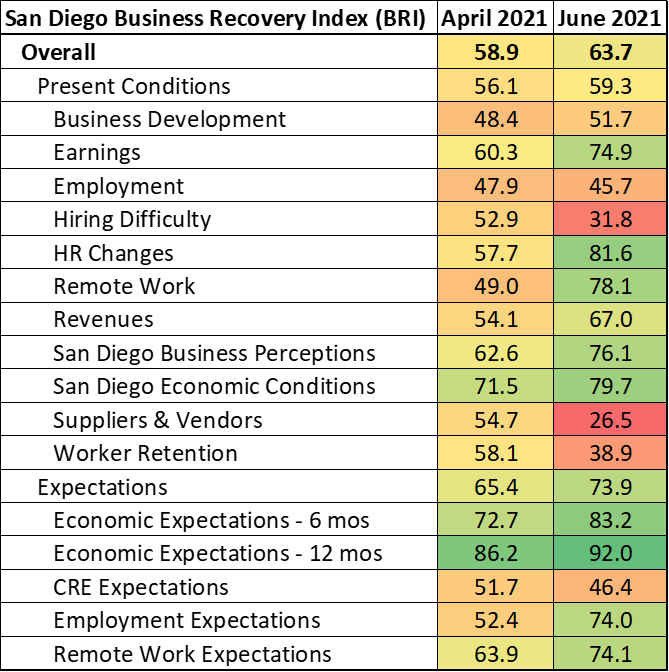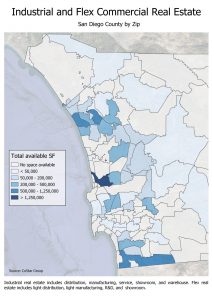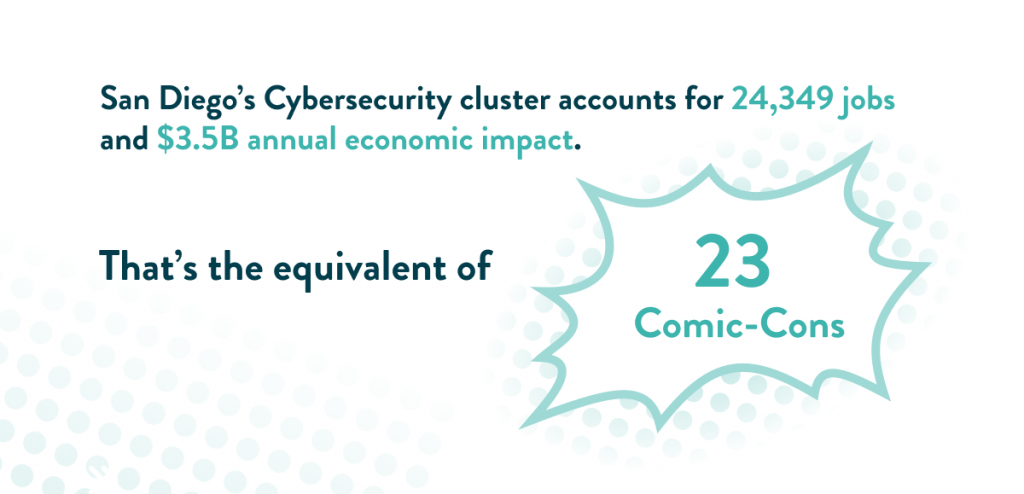Presented by Meyers Nave, this edition of San Diego’s Data Bites covers August 2021, with data on employment and more insights about the region’s economy at this moment in time. Check out EDC’s Research Bureau for even more data and stats about San Diego.
KEY TAKEAWAYS
- San Diego establishments added a less-than-stellar 5,300 jobs in August, undoing July’s seasonal loss. Gains were concentrated in Construction and Government as teachers and school staff were brought back onto payrolls in preparation for kids’ return to the classroom.
- The unemployment rate dipped to 6.6 percent in August from July’s 6.9 percent. However, this was due to 11,800 people leaving the workforce, not job gains.
- August’s employment report provides more evidence that emergency federal unemployment insurance (UI) benefits are not sidelining workers, contrary to popular belief. Yet the data do point to another potential reason: workers are refusing to return because of the risk of exposure to COVID amid low pay and no healthcare benefits.
The data
San Diego companies added an underwhelming 5,300 jobs in August, while the exit of 11,800 workers lowered the unemployment rate to 6.6 percent from July’s 6.9 percent. August’s jobs build erases July’s loss, but the region still lags behind the national jobs recovery. Just over half of the jobs shed during the pandemic have been recovered locally, compared with about 80 percent nationwide.
Public agencies led the charge in August, adding 3,500 positions as teachers and school staff were brought back onto payrolls as kids prepared to return to the classroom. Construction came in at a close second, adding 3,400 jobs last month. However, Leisure and Hospitality, which has led job gains for nearly all of the recovery, added just 2,000 payrolls, potentially reflecting a change in preferences and attitudes among workers (more on that below). Transportation, Warehousing, and Professional and Business Services added another 600 jobs combined.
Gains in those industries were partially offset by losses in Other Services (gyms, salons, building and grounds maintenance, etc.), Finance, Wholesale Trade, Manufacturing, Retail, Healthcare, and private Educational Services.
Exposure, health insurance, and the jobs recovery
August’s employment report provides more evidence that UI benefits are not sidelining workers, contrary to popular belief. The line of thinking has been that an extra $300 per week in federal UI benefits is substantial enough for lower-paid workers in service industries to not return to the workforce. However, those emergency UI benefits terminate in early September, so the expectation would be for thousands of idle workers to return as the UI windfall is rolled off ahead of that.
To be sure, $300 per week amounts to just less than half of the gross pay received by workers in San Diego’s Leisure and Hospitality sector. Yet, Leisure and Hospitality establishments added a mere 2,000 net positions last month with another 33,200 jobs yet to be recovered.
The data may not support the notion that UI benefits are keeping workers home, but they do point to another potential reason: workers are refusing to return because of the risk of exposure to COVID amid low pay and no healthcare benefits. San Diego COVID cases, including the Delta and Mu variants, have fallen since peaking in mid-August, thanks to the County’s high vaccination rate, but they nonetheless remain higher than levels seen in May and June of this year. Many workers in lower-paying, public-facing positions may have therefore concluded that going back to work at $15 per hour isn’t worth the risk of exposure, even if it means forfeiting an extra $1,200 per month in federal UI benefits.
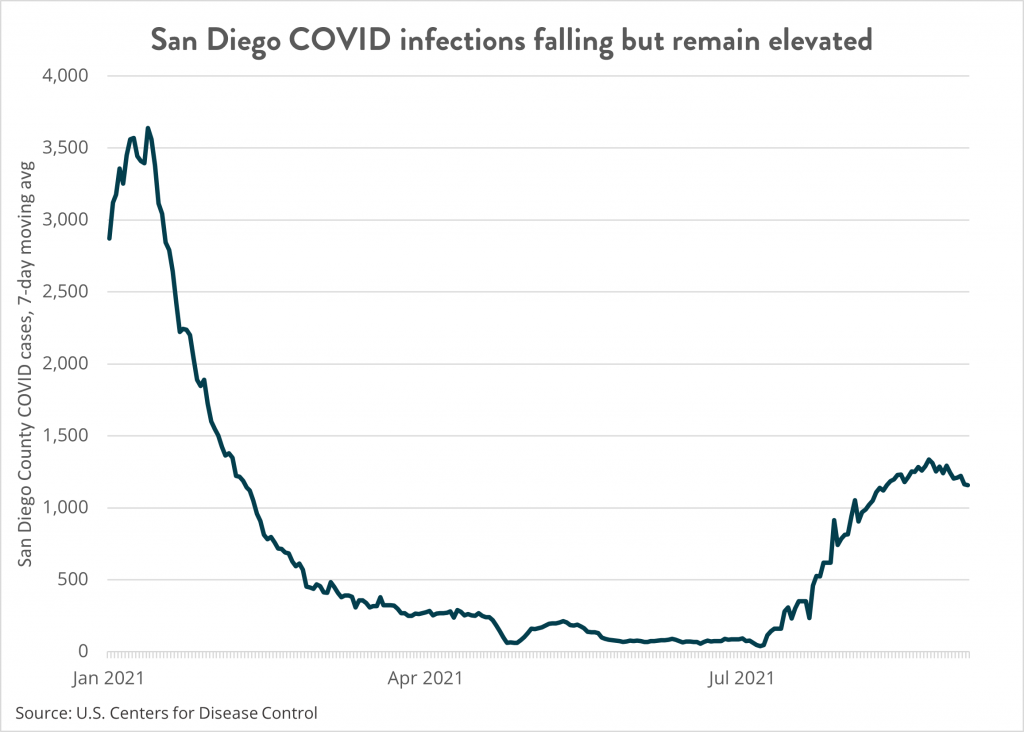
The San Diego region is yet to recoup 107,900 jobs lost during the pandemic, 60 percent of which are in industries that are either public-facing or have limited capacity for social distancing, such as Leisure and Hospitality, Retail, Education, and Manufacturing. However, most of these industries are closing in on pre-pandemic employment levels, while Leisure and Hospitality is not.
A combination of steady job growth and the rollout of health insurance mandates through the Affordable Care Act significantly reduced the number of uninsured San Diegans during the 2010s. Even with the expansion of insurance coverage, however, EDC estimates that anywhere from 11,000 to 17,000 people have been left without any health benefits since February 2020 as their jobs evaporated or they left the labor force.
Worse, many can’t even rely on getting jobs for health coverage. Nearly 10 percent of employed people in San Diego still lack any sort of health insurance; that number jumps to 16 percent for food preparation and serving-related positions at restaurants and bars and climbs as high as 29 percent for building and grounds maintenance positions. But those figures also include public insurance. Excluding public insurance options, some 54 percent of food prep workers and servers and 60 percent of building and grounds workers receive no health insurance through their employer or union.
Estimates for average hospital costs associated with COVID-19 treatment range from $30,000 to $50,000. A Kaiser Family Foundation study also found that 72 percent of major health insurance plans across the U.S. have already stopped full coverage of COVID-related treatments, and that will increase to 93 percent by year-end. Meanwhile, the average annual salary for food prep workers and servers in San Diego is $29,500. Hence, being infected by COVID or one of its variants could easily spell financial ruin for these workers even if they already have health coverage. Faced with those statistics, it would be more financially irresponsible to return to work than to stay home and wait out the recent spate of COVID infections.
Taken together, it’s safe to assume that many lower-paid service workers in public-facing jobs may not return anytime soon until the benefits clearly outweigh the risk. This puts low-margin local businesses in service industries in a precarious position: either lure workers back with higher pay and/or benefits and pass on the additional costs to customers, or run the risk of operating at less than 100 percent capacity, which would crimp revenues and also hurt bottom lines.
Regardless of the answer to that question, these data underscore the desperate need for more quality jobs in the area, particularly at smaller companies, if we ever hope to restore a sense of normalcy in the job market going forward. Humans may be creatures of habit, but large-scale economic displacement has a way of fundamentally altering our preferences and routines. The pandemic-fueled recession last year has almost certainly led workers to place greater importance on their personal safety and health than before, and employers will need to adapt in order to attract and retain talent.
